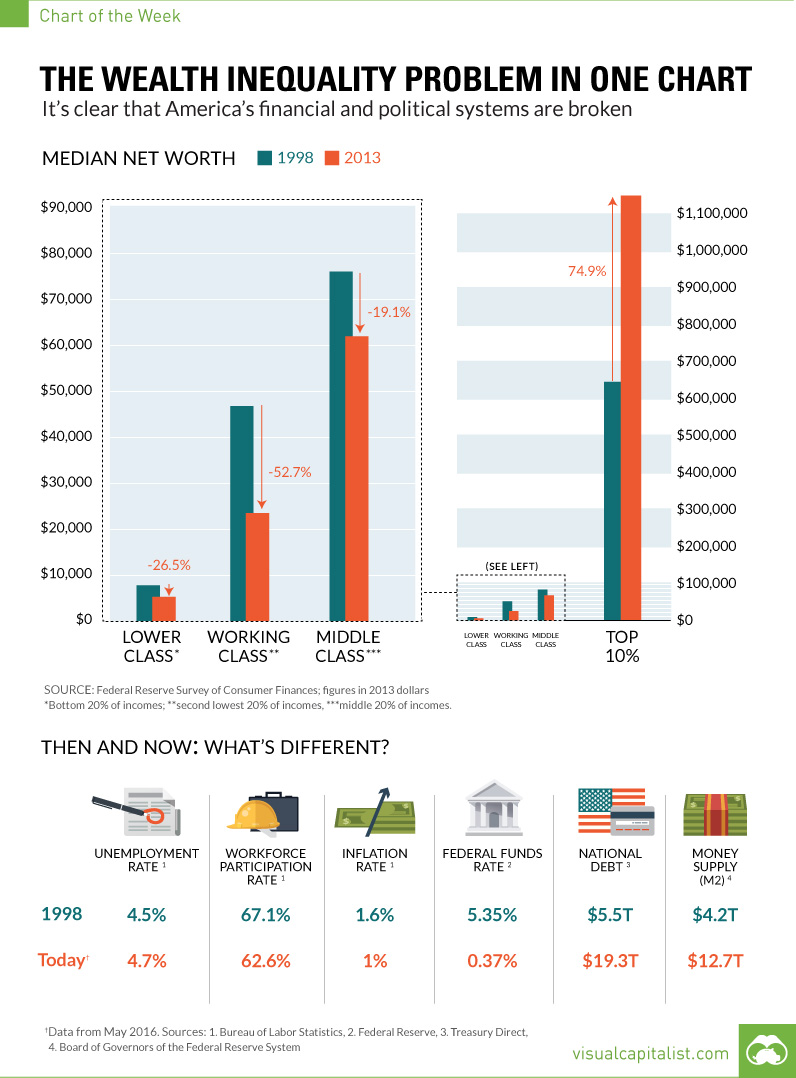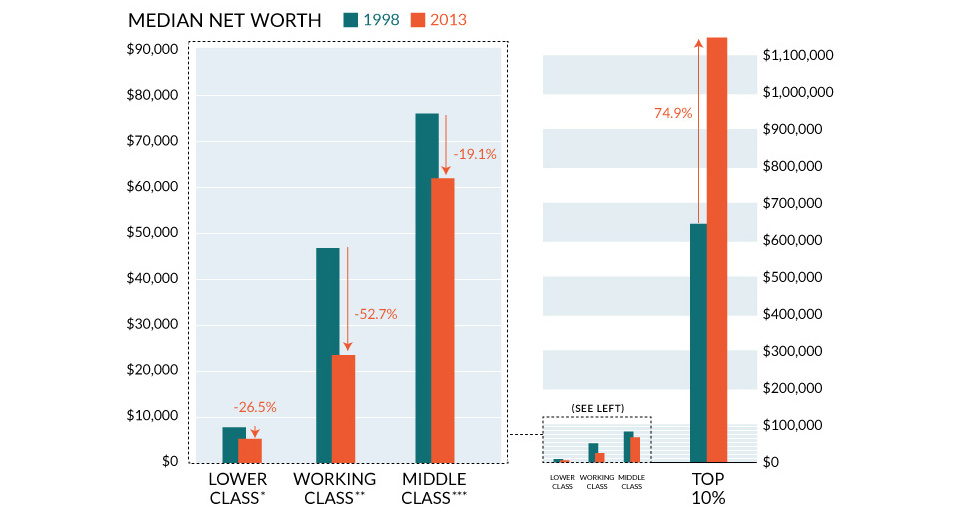Markets
The Wealth Inequality Problem in One Chart

The Wealth Inequality Problem in One Chart
It’s clear that America’s financial and political systems are broken
The Chart of the Week is a weekly Visual Capitalist feature on Fridays.
It seems that people don’t agree on much these days, but there is one growing exception to that rule.
Across the board, Americans are finding that the “system” isn’t working for most people in its current state. Donald Trump and Bernie Sanders have locked into this sentiment to garner unprecedented support as outsider candidates, and there is an undeniable feeling in the air that something has got to give.
Why is there so much conviction that things must change?
The Wealth Inequality Problem
In today’s chart, we showcase the wealth inequality problem in the best way we could. The challenge with it was that literally the data goes “off” the chart with no easy way to show it.
On the chart, we plotted the “Median Net Worth” of different wealth groups between 1998 and 2013. This is based on a study that the Federal Reserve does about every three years on consumer finances.
When this data is compared in 2013 dollars:
- The Lower Class: Wealth has decreased by 26.5% for the bottom 20% of incomes
- The Working Class: Wealth has decreased by 52.7% for the second lowest 20% of incomes
- The Middle Class: Wealth has decreased by 19.1% for the middle 20% of incomes
However, one segment has shot up “off” the charts:
- The Top 10%: Wealth has increased 74.9%, soaring to a median net worth of over $1.1 million.
Then and Now
What’s changed between then and now?
We looked at this from a macroeconomic perspective to get a sense of what has changed between 1998 and today, using latest data from last month (May 2016).
- Unemployment is relatively flat between 1998 and today, but the amount of people actively looking for work has dropped by 4.5%. With more workers discouraged since the 2008 crisis, Workforce participation has dropped steadily. Economists also say this is likely due to a rapidly aging population.
- Inflation has averaged between 0% and 1% over the last three years. It is currently sitting at 1%. In 1998, inflation was closer to the Fed’s 2% target.
- The Federal Funds Rate, which is the rate that generally acts as a backbone for interest rates across the country, has dropped like a rock. Right now it was effectively 0.37% in May 2016, way down from 5% to 6% that existed for most of the 90s.
- National Debt has almost quadrupled in nominal terms from $5.5 trillion (1998) to $19.3 trillion today. In real terms, taking into account inflation, it has more than doubled.
- Money Supply (M2) has increased from $4.2 trillion (1998) to $12.7 trillion today. About $5 trillion of this increase came after the 2008 crisis.
And while there are many factors that go into wealth inequality, we believe that some of the above factors are worth exploring and understanding in detail.
For example, who benefits from 0% interest rates the most?
Who owns assets like real estate or stocks that have their prices propped up by these policies?
Who can borrow capital at low rates to invest or speculate on rises in these prices – is it the people that already have money, or the people without any?
Where does all the extra money that is added to the system go?
What is each $1 trillion of new U.S. debt spent on, and do the benefits of this added debt outweigh the costs?
Markets
The European Stock Market: Attractive Valuations Offer Opportunities
On average, the European stock market has valuations that are nearly 50% lower than U.S. valuations. But how can you access the market?

European Stock Market: Attractive Valuations Offer Opportunities
Europe is known for some established brands, from L’Oréal to Louis Vuitton. However, the European stock market offers additional opportunities that may be lesser known.
The above infographic, sponsored by STOXX, outlines why investors may want to consider European stocks.
Attractive Valuations
Compared to most North American and Asian markets, European stocks offer lower or comparable valuations.
| Index | Price-to-Earnings Ratio | Price-to-Book Ratio |
|---|---|---|
| EURO STOXX 50 | 14.9 | 2.2 |
| STOXX Europe 600 | 14.4 | 2 |
| U.S. | 25.9 | 4.7 |
| Canada | 16.1 | 1.8 |
| Japan | 15.4 | 1.6 |
| Asia Pacific ex. China | 17.1 | 1.8 |
Data as of February 29, 2024. See graphic for full index names. Ratios based on trailing 12 month financials. The price to earnings ratio excludes companies with negative earnings.
On average, European valuations are nearly 50% lower than U.S. valuations, potentially offering an affordable entry point for investors.
Research also shows that lower price ratios have historically led to higher long-term returns.
Market Movements Not Closely Connected
Over the last decade, the European stock market had low-to-moderate correlation with North American and Asian equities.
The below chart shows correlations from February 2014 to February 2024. A value closer to zero indicates low correlation, while a value of one would indicate that two regions are moving in perfect unison.
| EURO STOXX 50 | STOXX EUROPE 600 | U.S. | Canada | Japan | Asia Pacific ex. China |
|
|---|---|---|---|---|---|---|
| EURO STOXX 50 | 1.00 | 0.97 | 0.55 | 0.67 | 0.24 | 0.43 |
| STOXX EUROPE 600 | 1.00 | 0.56 | 0.71 | 0.28 | 0.48 | |
| U.S. | 1.00 | 0.73 | 0.12 | 0.25 | ||
| Canada | 1.00 | 0.22 | 0.40 | |||
| Japan | 1.00 | 0.88 | ||||
| Asia Pacific ex. China | 1.00 |
Data is based on daily USD returns.
European equities had relatively independent market movements from North American and Asian markets. One contributing factor could be the differing sector weights in each market. For instance, technology makes up a quarter of the U.S. market, but health care and industrials dominate the broader European market.
Ultimately, European equities can enhance portfolio diversification and have the potential to mitigate risk for investors.
Tracking the Market
For investors interested in European equities, STOXX offers a variety of flagship indices:
| Index | Description | Market Cap |
|---|---|---|
| STOXX Europe 600 | Pan-regional, broad market | €10.5T |
| STOXX Developed Europe | Pan-regional, broad-market | €9.9T |
| STOXX Europe 600 ESG-X | Pan-regional, broad market, sustainability focus | €9.7T |
| STOXX Europe 50 | Pan-regional, blue-chip | €5.1T |
| EURO STOXX 50 | Eurozone, blue-chip | €3.5T |
Data is as of February 29, 2024. Market cap is free float, which represents the shares that are readily available for public trading on stock exchanges.
The EURO STOXX 50 tracks the Eurozone’s biggest and most traded companies. It also underlies one of the world’s largest ranges of ETFs and mutual funds. As of November 2023, there were €27.3 billion in ETFs and €23.5B in mutual fund assets under management tracking the index.
“For the past 25 years, the EURO STOXX 50 has served as an accurate, reliable and tradable representation of the Eurozone equity market.”
— Axel Lomholt, General Manager at STOXX
Partnering with STOXX to Track the European Stock Market
Are you interested in European equities? STOXX can be a valuable partner:
- Comprehensive, liquid and investable ecosystem
- European heritage, global reach
- Highly sophisticated customization capabilities
- Open architecture approach to using data
- Close partnerships with clients
- Part of ISS STOXX and Deutsche Börse Group
With a full suite of indices, STOXX can help you benchmark against the European stock market.

Learn how STOXX’s European indices offer liquid and effective market access.

-

 Economy3 days ago
Economy3 days agoEconomic Growth Forecasts for G7 and BRICS Countries in 2024
The IMF has released its economic growth forecasts for 2024. How do the G7 and BRICS countries compare?
-

 Markets2 weeks ago
Markets2 weeks agoU.S. Debt Interest Payments Reach $1 Trillion
U.S. debt interest payments have surged past the $1 trillion dollar mark, amid high interest rates and an ever-expanding debt burden.
-

 United States2 weeks ago
United States2 weeks agoRanked: The Largest U.S. Corporations by Number of Employees
We visualized the top U.S. companies by employees, revealing the massive scale of retailers like Walmart, Target, and Home Depot.
-

 Markets2 weeks ago
Markets2 weeks agoThe Top 10 States by Real GDP Growth in 2023
This graphic shows the states with the highest real GDP growth rate in 2023, largely propelled by the oil and gas boom.
-

 Markets3 weeks ago
Markets3 weeks agoRanked: The World’s Top Flight Routes, by Revenue
In this graphic, we show the highest earning flight routes globally as air travel continued to rebound in 2023.
-

 Markets3 weeks ago
Markets3 weeks agoRanked: The Most Valuable Housing Markets in America
The U.S. residential real estate market is worth a staggering $47.5 trillion. Here are the most valuable housing markets in the country.
-

 Science1 week ago
Science1 week agoVisualizing the Average Lifespans of Mammals
-

 Markets2 weeks ago
Markets2 weeks agoThe Top 10 States by Real GDP Growth in 2023
-

 Demographics2 weeks ago
Demographics2 weeks agoThe Smallest Gender Wage Gaps in OECD Countries
-

 United States2 weeks ago
United States2 weeks agoWhere U.S. Inflation Hit the Hardest in March 2024
-

 Green2 weeks ago
Green2 weeks agoTop Countries By Forest Growth Since 2001
-

 United States2 weeks ago
United States2 weeks agoRanked: The Largest U.S. Corporations by Number of Employees
-

 Maps2 weeks ago
Maps2 weeks agoThe Largest Earthquakes in the New York Area (1970-2024)
-

 Green2 weeks ago
Green2 weeks agoRanked: The Countries With the Most Air Pollution in 2023












